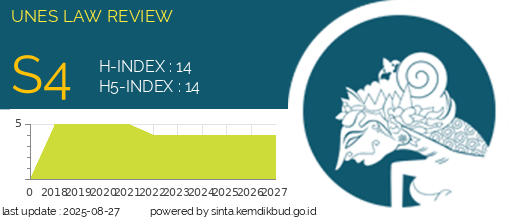Identifikasi Indikasi Geografis Pada Tenunan Sapu Lu’e Lawo dan Perlindungan Hukum sebagai Hak Kekayaan Intelektual Komunal pada Masyarakat Adat Bajawa
DOI:
https://doi.org/10.31933/unesrev.v6i1.814Keywords:
Geographical Indication Identification, Lue Lawo Broom Weave, Legal Protection, Communal Intellectual Property, Bajawa Indigenous People.Abstract
Sapu Lu'e Lawo is a set of woven traditional clothes for men and women in the Bajawa indigenous community. This weave has Geographical Indication characteristics as one of the communal intellectual property. Geographical Indication is a sign indicating the area of origin of an item and or product which due to geographical environmental factors including natural factors, human factors, or a combination of both factors gives a certain reputation, quality, and characteristics to the goods and/or products produced. The main problem of this research is how the geographical indication of the Lu'e Lawo broom weave and how the form of legal protection. This type of research is Sociological Jurisprudence that relies on document studies as well as empirical studies through observation methods and in-depth interviews with weavers and leaders. The results of the study found that there is an element of geographical indication in the weaving of Sapu Lu'e Lawo which is a combination of natural factors, human factors and a combination of both factors contained in the shape, motif, color, material and value message in the ritual of making it, so it requires legal protection in accordance with applicable laws and regulations. The conclusion is that Sapu Lu'e Lawo is a set of woven traditional clothing in the Bajawa customary law community that contains the quality, characteristics and reputation as a geographical indication that must be protected. It is recommended that the local government make policies that facilitate weavers' access to the availability of natural materials such as encouraging the expansion of new plantations to support the economy as well as preserving the living values of the Bajawa indigenous people.
Downloads
References
Bao, S. O. (1992). Seni Tenun Suatu Segi Kebudayaan Orang Flores. Seminari Tinggi ST. Paulus , Ledaro. https://lib.ui.ac.id
Demu, Y. T. (2011). Mutiara-mutiara budaya Ngadha yang berceceran : dalam proses pembangunan masyarakat dan gereja. Ardent publishing.
Fajar, Mukti ; Achmad, Y. (2010). Dualisme penelitian hukum : normatif & empiris. Yogyakarta : Pustaka Pelajar.
Geme, M. T. (2012). Perlindungan Hukum terhadap Masyarakat Hukum Adat (Woe) dalam Pengelolaan Cagar Alam Watu Ata Kabupaten Ngada Provinsi Nusa Tenggara Timur. Universitas Brawijaya. https://scholar.google.co.id/citations?view_op=view_citation&hl=id&user=Z1_G8NwAAAAJ&citation_for_view=Z1_G8NwAAAAJ:u5HHmVD_uO8C
Hadjon, P. M. (1987). Perlindungan hukum bagi rakyat di Indonesia. Bina Ilmu.
Peraturan Menteri Hukum dan HAM Nomor 12 Tahun 2019 tentang Indikasi Geografis, (2019). https://peraturan.bpk.go.id/Home/Details/133127/permenkumham-no-12-tahun-2019
Hidayat, F. (2014). Penerapan Perlindungan Hukum Terhadap Produk Potensi Indikasi Geografis di Indonesia. Risalah HUKUM Fakultas Hukum Unmul, 10(1), 72–83. file:///Users/stefanusdonrade/Downloads/aam19,+7.Penerapan+Perlindungan+Hukum+Terhadap+Produk+Potensi+Indikasi+Geografis+di+Indonesia++Fitri+Hidayat.pdf
KETETAPAN MAJELIS PERMUSYAWARATAN RAKYAT REPUBLIK INDONESIA NOMOR IX/MPR/2001, (2001).
Labu, N. (2014). Pakaian Adat Jati Diri Orang Ngadha.
Marsianus Ampat, Yustinus Pedo, Ernesta Uba Wohon, & Don Rade, S. (2023). Tu’a Golo’s role in resolving land disputes between Poka indigenous people, Longko Village, Wae Ri’i District, Manggarai Regency. Al Ahkam, 19(1), 48–58. https://doi.org/10.37035/ajh.v19i1.8962
Masrur, D. R. (2018). PERLINDUNGAN HUKUM INDIKASI GEOGRAFIS YANG TELAH DIDAFTARKAN SEBAGAI MEREK BERDASARKAN INSTRUMEN HUKUM NASIONAL DAN HUKUM INTERNASIONAL. Lex Jurnalica, 15(2). https://doi.org/https://doi.org/10.47007/lj.v15i2.2440
Putranti, Deslaely; Indriyani, D. A. (2021). PERLINDUNGAN INDIKASI GEOGRAFIS OLEH MASYARAKAT PERLINDUNGAN INDIKASI GEOGRAFIS PASCA SERTIFIKASI DI YOGYAKARTA. Jurnal Ilmiah Kebijakan Hukum, 15(3), 395–414. https://doi.org/http://dx.doi.org/10.30641/kebijakan.2021.V15.395-414
Rade, S. D., & Wohon, E. U. (2022). Perlindungan Konsumen Terhadap Pencantuman Komposisi Produk Ditinjau Dari Undang-Undang Nomor 8 Tahun 1999 Tentang Perlindungan Konsumen. Syntax Literate; Jurnal Ilmiah Indonesia, 7(11), 16168–16178.
Rahmatullah, I. (2014). Perlindungan Indikasi Geografis Dalam Hak Kekayaan Intelektual (HKI) Melalui Ratifikasi Perjanjian Lisabon. JURNAL CITA HUKUM, 2(2). https://doi.org/10.15408/jch.v1i2.1470
Santyaningtyas, Ayu Citra ;Tektona, R. I. (2019). Melindungi Hak Masyarakat Adat di Indonesia Pada Penyalahgunaan Ekspresi Budaya Tradisional di Indonesia. Jurnal Heritage, 7(1), 41–44. https://doi.org/10.35891/heritage.v7i1.1571
Sinaga, V. S. (2014). Faktor-Faktor Penyebab Rendahnya Penggunaan Hak Kekayaan Intelektual di Kalangan Usaha Kecil Menengah Batik. JURNAL HUKUM IUS QUIA IUSTUM, 21(1), 61–80. https://doi.org/10.20885/iustum.vol21.iss1.art4
Susanti, Diah Imaningrum ; Indradadi, A. (2018). Perlindungan negara atas warisan budaya bangsa. Setara Press.
Susanti, D. I., Sudhiarsa, R. I. M., & Susrijani, R. (2019). Ekspresi budaya tradisional dan hak kekayaan intelektual. Percetakan Dioma Malang.
Wulansari, C. D. (2014). Hukum Adat di Indonesia: Suatu Pengantar. In Refika Aditama.



















